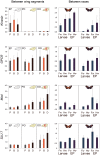Genomic hotspots for adaptation: the population genetics of Müllerian mimicry in the Heliconius melpomene clade
- PMID: 20140188
- PMCID: PMC2816687
- DOI: 10.1371/journal.pgen.1000794
Genomic hotspots for adaptation: the population genetics of Müllerian mimicry in the Heliconius melpomene clade
Abstract
Wing patterning in Heliconius butterflies is a longstanding example of both Müllerian mimicry and phenotypic radiation under strong natural selection. The loci controlling such patterns are "hotspots" for adaptive evolution with great allelic diversity across different species in the genus. We characterise nucleotide variation, genotype-by-phenotype associations, linkage disequilibrium, and candidate gene expression at two loci and across multiple hybrid zones in Heliconius melpomene and relatives. Alleles at HmB control the presence or absence of the red forewing band, while alleles at HmYb control the yellow hindwing bar. Across HmYb two regions, separated by approximately 100 kb, show significant genotype-by-phenotype associations that are replicated across independent hybrid zones. In contrast, at HmB a single peak of association indicates the likely position of functional sites at three genes, encoding a kinesin, a G-protein coupled receptor, and an mRNA splicing factor. At both HmYb and HmB there is evidence for enhanced linkage disequilibrium (LD) between associated sites separated by up to 14 kb, suggesting that multiple sites are under selection. However, there was no evidence for reduced variation or deviations from neutrality that might indicate a recent selective sweep, consistent with these alleles being relatively old. Of the three genes showing an association with the HmB locus, the kinesin shows differences in wing disc expression between races that are replicated in the co-mimic, Heliconius erato, providing striking evidence for parallel changes in gene expression between Müllerian co-mimics. Wing patterning loci in Heliconius melpomene therefore show a haplotype structure maintained by selection, but no evidence for a recent selective sweep. The complex genetic pattern contrasts with the simple genetic basis of many adaptive traits studied previously, but may provide a better model for most adaptation in natural populations that has arisen over millions rather than tens of years.
Conflict of interest statement
The authors have declared that no competing interests exist.
Figures





Similar articles
-
Genomic hotspots for adaptation: the population genetics of Müllerian mimicry in Heliconius erato.PLoS Genet. 2010 Feb 5;6(2):e1000796. doi: 10.1371/journal.pgen.1000796. PLoS Genet. 2010. PMID: 20140239 Free PMC article.
-
Highly conserved gene order and numerous novel repetitive elements in genomic regions linked to wing pattern variation in Heliconius butterflies.BMC Genomics. 2008 Jul 22;9:345. doi: 10.1186/1471-2164-9-345. BMC Genomics. 2008. PMID: 18647405 Free PMC article.
-
The genetic architecture of adaptation: convergence and pleiotropy in Heliconius wing pattern evolution.Heredity (Edinb). 2019 Aug;123(2):138-152. doi: 10.1038/s41437-018-0180-0. Epub 2019 Jan 22. Heredity (Edinb). 2019. PMID: 30670842 Free PMC article.
-
The functional basis of wing patterning in Heliconius butterflies: the molecules behind mimicry.Genetics. 2015 May;200(1):1-19. doi: 10.1534/genetics.114.172387. Genetics. 2015. PMID: 25953905 Free PMC article. Review.
-
Hybrid speciation in Heliconius butterflies? A review and critique of the evidence.Genetica. 2011 May;139(5):589-609. doi: 10.1007/s10709-010-9530-4. Epub 2010 Nov 28. Genetica. 2011. PMID: 21113790 Free PMC article. Review.
Cited by
-
Selective sweeps on novel and introgressed variation shape mimicry loci in a butterfly adaptive radiation.PLoS Biol. 2020 Feb 6;18(2):e3000597. doi: 10.1371/journal.pbio.3000597. eCollection 2020 Feb. PLoS Biol. 2020. PMID: 32027643 Free PMC article.
-
The evolution and genetics of sexually dimorphic 'dual' mimicry in the butterfly Elymnias hypermnestra.Proc Biol Sci. 2021 Jan 13;288(1942):20202192. doi: 10.1098/rspb.2020.2192. Epub 2021 Jan 13. Proc Biol Sci. 2021. PMID: 33434461 Free PMC article.
-
Synchrotron-source micro-x-ray computed tomography for examining butterfly eyes.Ecol Evol. 2024 Apr 1;14(4):e11137. doi: 10.1002/ece3.11137. eCollection 2024 Apr. Ecol Evol. 2024. PMID: 38571794 Free PMC article.
-
The population genomics of repeated evolution in the blind cavefish Astyanax mexicanus.Mol Biol Evol. 2013 Nov;30(11):2383-400. doi: 10.1093/molbev/mst136. Epub 2013 Aug 8. Mol Biol Evol. 2013. PMID: 23927992 Free PMC article.
-
Recombination rate variation shapes barriers to introgression across butterfly genomes.PLoS Biol. 2019 Feb 7;17(2):e2006288. doi: 10.1371/journal.pbio.2006288. eCollection 2019 Feb. PLoS Biol. 2019. PMID: 30730876 Free PMC article.
References
-
- Onuma Y, Takahashi S, Asashima M, Kurata S, Gehring WJ. Conservation of Pax 6 function and upstream activation by Notch signaling in eye development of frogs and flies. Proceedings of the National Academy of Sciences of the United States of America. 2002;99:2020–2025. doi: 10.1073/pnas.022626999. - DOI - PMC - PubMed
-
- Mundy NI. A window on the genetics of evolution: MC1R and plumage colouration in birds. Proceedings of the Royal Society B: Biological Sciences. 2005;272:1633–1640. doi: 10.1098/rspb.2005.3107. - DOI - PMC - PubMed
-
- Hoekstra HE, Hirschmann RJ, Bundey RA, Insel PA, Crossland JP. A single amino acid mutation contributes to adaptive beach mouse color pattern. Science. 2006;313:101–4. doi: 10.1126/science.1126121. - DOI - PubMed
-
- Nachman MW, Hoekstra HE, D'Agostino SL. The genetic basis of adaptive melanism in pocket mice. Proc Natl Acad Sci U S A. 2003;100:5268–5273. doi: 10.1073/pnas.0431157100. - DOI - PMC - PubMed
-
- Colosimo PF, Hosemann KE, Balabhadra S, Villarreal G, Dickson M, et al. Widespread Parallel Evolution in Sticklebacks by Repeated Fixation of Ectodysplasin Alleles. Science. 2005;307:1928–1933. doi: 10.1126/science.1107239. - DOI - PubMed
Publication types
MeSH terms
Substances
Grants and funding
LinkOut - more resources
Full Text Sources
Other Literature Sources
Research Materials

